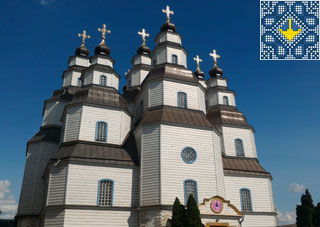|
Novomoskovsk Sights | Wooden Nine-Dome Holy Trinity Cathedral (1778) Individual and group tours to Novomoskovsk |
By 1770 Cossacks Council decided to organize construction of a new cathedral: the central hall is dedicated to Holy Trinity, right hall - holy apostles Peter and Paul, left hall - three saints Basil the Great, Gregory the Theologian, John Chrysostom. At the same time they decided that during the construction of the cathedral not a single iron nail should be used as "it is not suitable in the temple of Savior crucified on the cross and nailed to it with iron nails" so builders should insert wooden nails only. The permission for the construction of a new cathedral was issued by Kyiv Metropolitan in summer of 1774 and was brought to Samarchik by Hieromonk David. After choosing a place Cossacks bought several wooden houses and dismantled them. On 2nd of June 1775 a few days before the destruction of Zaporozhzhya Sich a place under Holy Trinity Cathedral was consecrated and laid its foundation. For the construction of a new cathedral Samara Cossacks invited a master from Novy Vodolag of Kharkiv province - Joachim Pogrebnyak who previously built 17 single-domed wooden churches. But the master suddenly disappeared. Evrybody thought that he was simply frightened of responsibility and anger of Cossacks. Only two months later Joachim appeared exhausted. All this time he spent in the floods near the monastery exhausting himself with fasting and prayers. At the meeting with Cossacks Council he proposed building a cathedral with 9 domes and drawing it on a blackboard (according to the legend - for greater visibility of the design he presented a model of the future temple woven from the vine which was stored until 1812 and then was crumbled into the dust of old age). Cossacks came to admiration and gave the master a fee of 2000 rubles for his work. Holy Trinity Cathedral was built according to all the canons of wooden architecture. The main tool for the preparation of bars was an ax. As the masters managed to achieve such high precision manufacturing of the details of the cathedral today remains a mystery. Three years Joachim Pogrebnyak built a temple. The dimensions and features of the building are truly impressive - the circumference of the building is about 124 meters and total area is 512 square meters. The walls of oak and pine logs pass into nine four-tier towers-domes. They are arranged in three rows each of which is the support of the neighbor creating a balance and harmony. Outside the cathedral is sheathed with white painted boards which gives the structure lightness and elegance accentuated by a central dome that rose to 35 meters. For this masterpiece of wooden architecture an outstanding national master received a kind of quality mark - "Certificate". On 13th of May 1778 the city celebrated the consecration of Holy Trinity Cathedral. The total cost of the new cathedral was 16 763 rubles 71 kopeeks - a colossal amount for that time. The construction of Wooden Nine-Dome Holy Trinity Cathedral was finished but the internal work lasted two more years. In its pristine form Novomoskovsk cathedral existed until the end of XIX century. But when the oak piles which served as the foundation decayed and the cathedral tilted. It was recognized as an emergency and ordered to demolish intending to build a stone church instead. In defense of the salvation of the cathedral stood famous historians Dmitry Yavornytsky and Yakov Novitsky. As a result the cathedral was rebuilt. In 80 years of XIX century Holy Trinity Cathedral was undergoing major overhaul under guidance of architect Karmansky. The building was completely dismantled but then the city authorities had reasonable doubts about financial cleanliness of restorers which was the reason for their shameful suspension from work. There were no masters who wish to continue construction on the site of the temple remained a pile of unnumbered logs and boards. Then the craftsman from Novy Vodolag of Kharkiv province - Alexei Pakhuchiy came to help. By the photo preserved by priest Ioanniki Vakhnin and the proportions of the iconostasis he managed to recreate the temple in its original form. The only difference was that now the cathedral rises on a brick foundation and a bell tower with a clock-chime of 35 meters high was erected nearby. The new bell tower was set up with 7 bells and the largest of which weighed 4206 kg. In the autumn of 1888 the cathedral again appeared in all its marvelous beauty. This was the first revival of Holy Trinity Cathedral. The first threat of destruction hung over the architectural masterpiece in the early 30-ies of the last century. It was decided to demolish it on the pretext of fighting against religion - in the summer of 1937 the cathedral tried to disassemble. However the intention of authorities was opposed by townspeople led by teachers-brothers Babkomalis: parishioners with stones in their hands met "onslaught" and students of Pedagogical School refused to participate in the destruction of the cathedral. In September 1941 with the beginning of Nazi occupation the religion service in the cathedral resumed. True fascist care about the cathedral was discovered two years later after liberation of the city by Soviet troops. Then it became known the name of another savior of the cathedral. He was thirteen-year-old son of the regiment Tolia Morozov. Driven by curiosity the boy began to search for an underground passage which according to rumors connected the cathedral with a monastery on the other bank of Samara river. In the basement the boy discovered a bunch of 32 anti-tank mines which was put by captain Gustav Walter and by a lucky chance the cathedral was not blown up. In the postwar period there was a new attempt to destroy Holy Trinity Cathedral. In Khrushchev's persecution by decision of Bureau of Novomoskovsk City Committee of CPU in 1963 the cathedral is again closed. To protect the monument was a famous writer and a native of Dnipropetrovsk - famous writer Oles Honchar. He writes eponymous novel "Cathedra" (Sobor) in which he raises the theme of not only the protection of monuments of architecture but also of human souls. In this campaign the classic of Ukrainian literature was supported by famous cultural figures like Mikhail Sholokhov, Mikhail Stelmakh, Petro Kazachenko. Vasily Shukshin and Sergiy Baruzdin. In 2017 Holy Trinity Cathedral is open and at the same time is under reconstruction - it is going renovation of the roof, details of the walls of the cathedral and bell tower. We hope that in 2018 completely reconstructed Holy Trinity Cathedral will become one of the recommended sight for tourists who visit Dnipropetrovsk region. You could visit Novomoskovsk Sights | Wooden Nine-Dome Holy Trinity Cathedral (1778) with |

Book your tour or request information: |
|
- please, look at reviews of tourists about our tours
|
© 2011 - 2022 All rights reserved |


